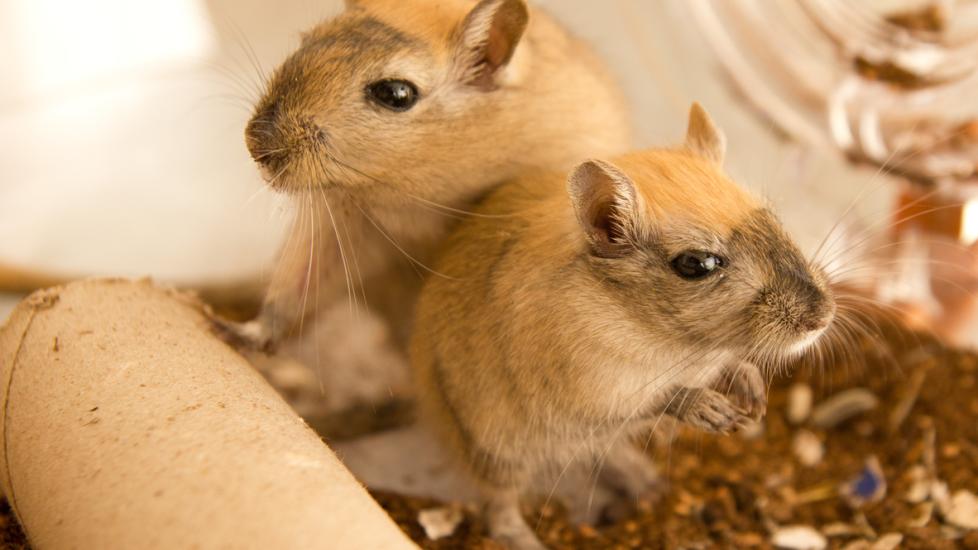Hamsters vs. Gerbils: What’s the Difference?
Hamsters and gerbils can both make wonderful pets for the right household. Both require research to determine if they are a good fit for your family. Hamsters and gerbils are both small rodents and are often confused with each other. While they may share some similar qualities, there are important differences—most notably temperament.
Temperament
The major difference between hamsters and gerbils is their behavior. While both can do well in captivity, gerbils are notoriously easier, more docile, and less likely to bite. Hamsters can become tame with frequent handling but will not tolerate being held for long and will bite when scared, sick, or with rough handling. Because of this, hamsters are not typically appropriate pets for children, while gerbils are very good beginner pets.
Physical Differences
Hamsters and gerbils are both small mammals and can fit in the palm of your hand. The males of both species are larger, weighing around 130 grams, or about 4.5 ounces. Their body size is anywhere from 2–4 inches long.
Tails are one of the main differences between the species. Hamsters have short and stubby tails, while gerbils have long tails—up to 4 inches. Facial features are another noticeable difference. Gerbils have long, pointy faces similar to mice, while hamsters have short and wide faces. Hamsters have cheek pouches to store and hoard food so they may look even chubbier!
Body types are another easily distinguishing feature. Gerbils are longer and leaner—making them athletic rodents, capable of jumping, running, and more agile maneuvers. Hamsters are also active, but are rounder with shorter legs, making them slightly less athletic.
As rodents, both species have continuously growing teeth. If not provided the proper husbandry along with toys, food, and appropriate housing materials to chew on, they can have severe dental issues—most notably overgrowth and abscesses.
Energy Levels
Both gerbils and hamsters have a lot of energy! However, hamsters are nocturnal and are most active at night. This means they may be noisy and playful when family members are trying to sleep. Gerbils, on the other hand, are active during the day. They can interact with their humans and sleep throughout the day and night. Both species do well on schedules that feature similar routines every day.
Gerbils are also highly social and thrive in pairs or small groups. In contrast, hamsters are known to be territorial and are usually much better suited to live on their own. They will even seriously hurt, even kill, other hamsters.
Hygiene
Both species are very clean and do not require shampoo and water baths. However, both, enjoy sand baths a few times a week. Make sure to use chinchilla sand, and not dust, to prevent health issues. These sand baths can keep coats healthy, less oily, and free of any potential parasites.
Housing & Diet
Both hamsters and gerbils require escape-proof cages with secure lids. Temperatures should be around 65–75 degrees and humidity around 50%. Both species prefer hide boxes to sleep in safety. They both enjoy frequent new rotations of toys and enrichment.
Based on the specific breed, some gerbils and hamsters may have slightly more specific temperature and humidity needs. Make sure to check with your veterinarian and review your pet’s husbandry.
Hamsters may occasionally enter a state of hibernation, called torpor, when temperatures are too low. Work with your veterinarian if you think your hamster is entering torpor. Any time a hamster or gerbil is lethargic, sleeping more than normal, and not eating normally is a red flag and a sign to call your veterinarian.
Hamsters and gerbils should both eat a species-specific pelleted diet. Neither species should eat seed-based diets, which are higher in calories. Both species require fresh water daily and can be offered occasional fresh vegetables. Hamsters can pack very large amounts of food into their cheek pouches. Make sure to monitor their cages for any hoarded or spoiled food.
While both species produce minimal odor and waste, gerbils may produce slightly less smell than hamsters. Cages should be spot-cleaned daily and deeply cleaned every two to four weeks.
Lifespan
Gerbils and hamsters have a similar lifespan. Five years is the oldest for both species, although hamsters usually only live one to two years and gerbils live three to five. They have similar gestation periods of less than a month and give live birth to their babies. Hamsters have slightly larger litters of up to nine, and pups from both species are weaned around three weeks old.
Handling
Neither species should be held by the tail to avoid injuries. Hamsters are much more likely to bite during handling, so wearing gloves or using towels may help. Two-handed scooping techniques are best used for gerbils and hamsters. To restrain for short periods of time, such as at the veterinarian, you may see a hamster being scruffed (picked up) by the excess amount of skin at their neck. Gerbils are more likely restrained by holding their head gently between two fingers.
Hamsters have poor eyesight, so it’s always a good idea to make a quiet noise before touching them, so they aren’t startled.
Both species should have human interactions for at least 30 minutes every day, as well as regular veterinary care at least once every year.
References
Help us make PetMD better
Was this article helpful?
